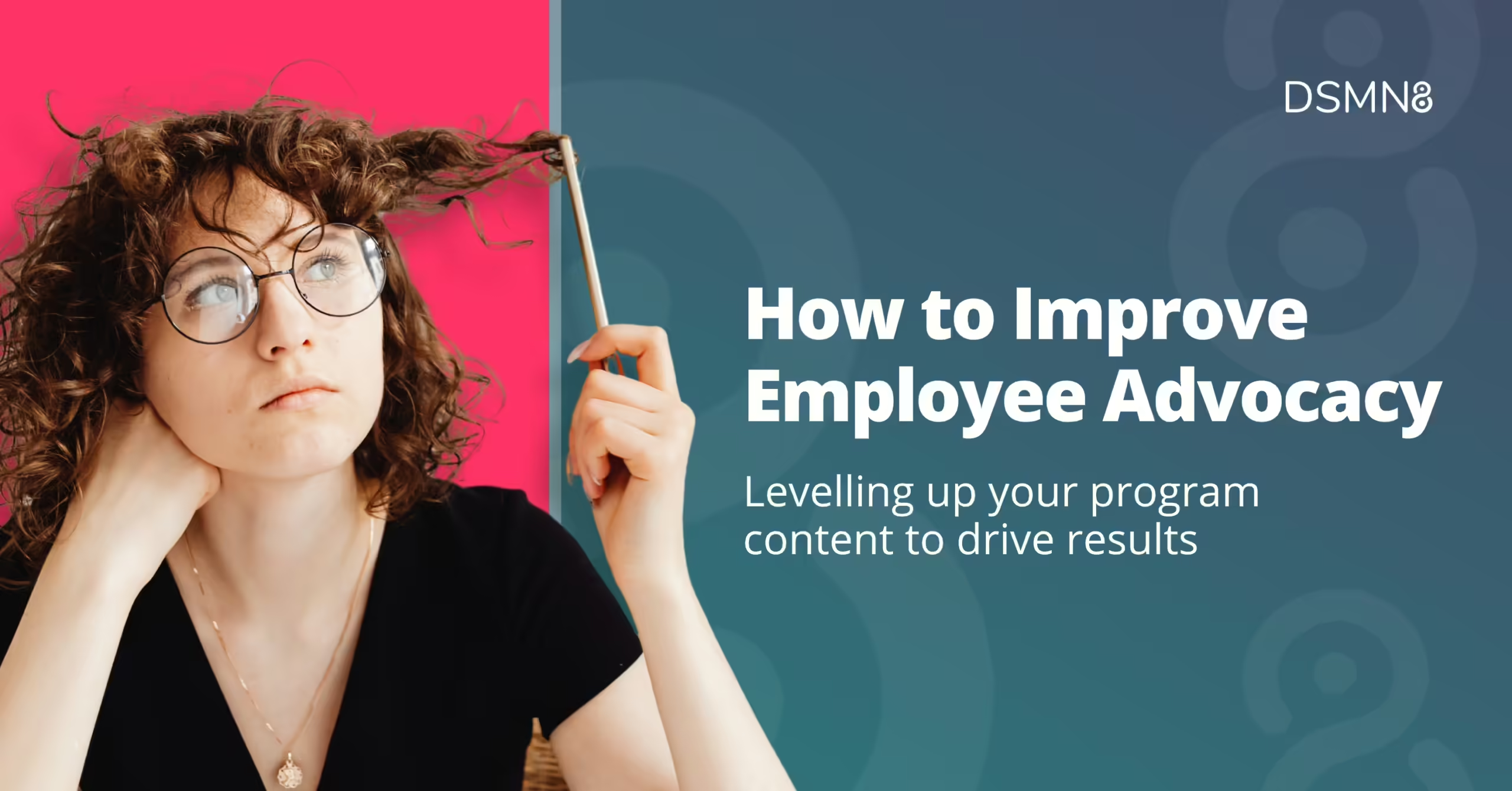
You’re running an employee advocacy program. It’s going well so far, and you’re looking to scale it up 🙌
Or perhaps it’s not working as well as you thought it would, and you’re trying to figure out why.
Well, you’re in luck.
Today we’re covering how to improve employee advocacy.
Everything from how to encourage employee engagement to how to fix common employee advocacy mistakes.
Let’s go!

It’s All About The Training
Yes, even your Millennial and Gen Z employees need social media training.
They need to know what to share, how to use your advocacy platform, and why you want them to post online in the first place!
If you’re running a small employee advocacy program and thinking about scaling up to include more employees, you really need to focus on the training.
Adding more and more users isn’t going to help if your employees aren’t sure about what they need to do.
Here’s a quick list of our best guides and resources to help you with employee advocacy training:
Encourage Engagement
It all starts with company culture.
Are your employees engaged, informed, and happy?
Did you know that engaged employees are 22% more productive, more punctual, more present, and more likely to stick around with their company? 💡
Happy and engaged employees are the goal. They make excellent employee advocates and the perfect employee influencers.
How does your company keep employees up-to-date? Do you have an internal comms app, social media, or email newsletters? Or all of the above?
A great way to improve your employee advocacy program is to improve your internal comms.
You’ve gotta tell employees about all the cool stuff you’re doing! If they don’t know about it, they won’t be sharing it on social media.
After the initial launch, it’s important to continue promoting your advocacy platform to bring more people on board.
Announcing your advocacy platform in one email isn’t enough! 🙅🏻♀️
Recognize efforts put in by your employee advocates, and train up new starters. Your employee advocacy program needs to become part of your day-to-day operations.

Look at the Analytics
If you’re using a platform like DSMN8, you’ll have a bunch of analytics to check out.
See what’s working well, and create similar content. The data is there to help you improve.
Share the stats with employees. Make them aware of the impact they’re having. It’s encouraging to find out your posts are getting high reach and engagement!

Talk To Employees About Their Experience
If your advocacy program isn’t getting the results you’re looking for, or there’s a lack of interest in joining, talk to your employees about it.
If you had a bunch of people sign up initially, then they lost interest… ask why.
Did something change?
Was it not considered a priority by management?
Is there not enough content to share?
Creating a survey for employees to share their feedback is the best way to do this.
Rather than guessing what’s going wrong, make changes based on suggestions from employees.

What Are Your Competitors Doing?
Make sure to check out what your competitors are doing on social.
What works well for them?
Which platforms have they built audiences on?
Answering these two questions could save you a lot of time. There’s no need to reinvent the wheel here.
Make a list of which competitors are smashing it on social, and key influencers from their companies💡
Get your employees to follow them on LinkedIn for inspiration and make a document with a bunch of post ideas from competitors.
Have a read of our blog post sharing our favorite employee advocacy examples to get started.
Remember that it’s not just about replicating what your competitors are doing. You’ve gotta stand out somehow!
Before telling your employees to make accounts on a new social platform, think about where your target audience actually hang out online.
Remember the hype around Clubhouse? Yeah… that didn’t last long 😬
Is your ideal client actually using TikTok, or are you jumping on the bandwagon because everyone says you should be using TikTok? 🤔
Common Employee Advocacy Mistakes and How To Fix Them
Now you’ve learnt how to improve employee advocacy in general…
It’s time to get specific.
Here are the most common employee advocacy mistakes that we come across all the time.
Don’t worry, we’ll tell you how to fix them! 💪

Lack of Knowledge
We’ve already mentioned how important employee advocacy training is… because it really is critical!
What if you’ve got the training down, everyone knows how to use your employee advocacy platform, and they know what they can and can’t post on social media… but you’re still not seeing results? 😭
Consider teaching employees about how to level up their content creation.
Your marketing team are pros at this! Ask them to run some content creation sessions with your employee advocates.
Create some resources to help employees understand what types of content works for each platform, and provide a bit of info about algorithms and optimal post times 🤓
Continuous learning is the way to go.
Start off with tips for LinkedIn, as that’s the main place for professional social media activity.
Use our LinkedIn guides as a starting point:
After that, consider which other platforms your employee advocates post on.
Writing on Twitter is different to writing on LinkedIn or Facebook… you need to be short and snappy! Make sure employees know how to find gifs for their tweets, and how to create Twitter threads too.
Instagram isn’t just about the photos… Reels are huge at the moment, and Instagram Stories are really popular too.
Hashtags are so important for getting visibility on Instagram – do your employees know how many they can use per post? Which ones are relevant to your industry niche?
💡 Top Tip: write a list of recommended hashtags. Include larger ones for your industry, but also your branded hashtag, networking hashtags, and smaller niche ones you’ll be able to stand out in.
If you’re using TikTok, there’s additional factors to think about when it comes to teaching content creation. Sounds, trends, video editing… Don’t expect employees to know it all straight away.
While a lot of the content to share will come from marketing and PR, you really should encourage employees to create original content too.
If employees are stuck for ideas, make a list of topics for them to talk about online, and provide examples of well performing posts from your channels.
Trying to get 100% Employee User Adoption
Think about which employees and departments are the most important for employee advocacy.
First of all, you’ll want senior leadership and marketing on board, as well as your sales reps.
Use the Pyramid of Employee Influence to help decide which employees to include.
They should be your priority before scaling up your advocacy program.
Don’t waste your time trying to convince (or force) every single employee to participate.

Relying Heavily on Gamification
If your company culture is great, employees will want to be involved.
They probably already do employee advocacy themselves, by sharing job openings or telling their friends about how much they love the company.
These people make the best employee advocates. The ones who believe in your mission, love their job, and would naturally recommend your company.
The best way to keep your employee advocates engaged is through recognition. Celebrate your results.
Check your analytics – did Ed from Sales get a bunch of likes and clicks on a LinkedIn post? Congratulate him! 🎉
We’re not against gamification… when it’s used correctly. The main mistake we see with gamification is when it becomes transactional 😬
For example, your employees are liking and sharing a bunch of stuff so they can get points for a new iPhone.
This is still providing engagement of course, but is it valuable? 🤔
What happens if you decide to remove or change the rewards?
Those employees would stop participating.
If you teach everyone about how employee advocacy helps the company AND the employee by encouraging them to build personal brands… rewards become more of a bonus than a payment 🙌
Our CEO, Bradley Keenan, talks about this in a podcast about gamification if you want to learn more!
Not Providing Enough Content
If you’re only adding 1 post to your advocacy platform every week, employees simply won’t have enough to share 😭
Besides, if everyone shares the same thing, it won’t look authentic.
You can’t expect amazing results from employee advocacy without having great content to share and enough of it.
Remember to mix it up with relevant third-party content, too! No offense, but it’s not all about your company.
Employees should aim to become authority figures in your industry, not just share company content all the time.
Otherwise, their social media profiles look like an ad for your business… and who would want to follow them?
Don’t have time to curate enough content? Explore DSMN8’s Managed Services.

Employee Advocacy Content Ideas
Need some ideas for employee advocacy content? Here ya go! 👇
- Company news
- Behind-the-scenes pics
- Success stories
- Interviews
- Community and charity activities
- Media features
- Industry news and research
Lack of Curation
Employees already have a lot of messages and emails to check every day.
If there’s a ton of content in their advocacy feed that doesn’t relate to them, it’ll take too much time to sort through it.
The solution?
Segment the feed by team, location, and topic focuses. This will make it easy for advocates to find content to share that their audience will be interested in.
Not Allowing Any Freedom
While it’s important to stay on brand, you do need to trust your employees.
Allow them to suggest ideas and reword the copy for their own LinkedIn profiles.
The goal isn’t to have every employee share identical posts. We’ve said it once and we’ll say it again… authenticity is the way! 👏
Our 2025 employee advocacy study of 500,000 LinkedIn posts revealed that original posts created by advocates outperform pre-written posts with 9x more engagement. But even if your team isn’t keen to create original content, just minor tweaks generated 3x more engagement.

Senior Leaders Aren’t Setting An Example
It can be tough to get c-suite executives onboard… they’re super busy people!
But once they understand the importance of employee advocacy, encourage them to lead by example.
Your CEO or CMO will likely have a larger social media following than most, which they can utilize to boost their personal brand and reach business goals.
If everyone at the company follows your leaders on social, they’ll know what kind of content you’re looking for!
You’re not using an employee advocacy platform, or the one you use isn’t working for you
Every company is different: what requirements do you need from an advocacy platform? 🤔
Are you working in a large enterprise that needs content segmented by region and language?
Does your marketing department primarily focus on video content? If so, your advocacy platform needs a video sharing feature (we do that!).
If you’re not getting the results, our customer success team at DSMN8 provides incredible support and tons of resources to help you level up. 📈
DSMN8’s Dedicated Customer Success Team
Whether you’re new to employee advocacy or switching from another platform, DSMN8 has your back.
Our customer success team takes you through the entire process, from setting up your advocacy platform to training employees and supporting your growth.
We’ve got the experience, the resources, and a dedicated team providing support based on your needs.
Emily Neal
SEO and Content Specialist at DSMN8. Emily has 10 years experience blogging, and is a pro at Pinterest Marketing, reaching 1 million monthly views. She’s all about empowering employees to grow their personal brands and become influencers.


